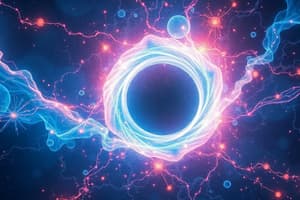Podcast
Questions and Answers
What is the charge of protons?
What is the charge of protons?
- Neutrally charged
- Negatively charged
- Varies depending on the atom
- Positively charged (correct)
Where are neutrons located within an atom?
Where are neutrons located within an atom?
- In the nucleus (correct)
- In the electron cloud
- Orbiting around the nucleus
- In the outer shell
How does the atomic number relate to the number of protons in an atom?
How does the atomic number relate to the number of protons in an atom?
- It varies independently of protons
- It is half the number of protons
- It is the same as the number of protons (correct)
- It is twice the number of protons
Which of the following statements about isotopes is correct?
Which of the following statements about isotopes is correct?
Who discovered the electron?
Who discovered the electron?
Which statement is true about the mass number of an atom?
Which statement is true about the mass number of an atom?
What can be concluded about the size of the nucleus in comparison to the overall atom?
What can be concluded about the size of the nucleus in comparison to the overall atom?
What keeps electrons in orbit around the nucleus?
What keeps electrons in orbit around the nucleus?
What does the atomic number of an element represent?
What does the atomic number of an element represent?
Which of the following statements about neutrons is true?
Which of the following statements about neutrons is true?
How is the mass number of an element calculated?
How is the mass number of an element calculated?
What defines an isotope of an element?
What defines an isotope of an element?
Which particle has no charge?
Which particle has no charge?
Which statement accurately represents the relationship between protons and electrons in a neutral atom?
Which statement accurately represents the relationship between protons and electrons in a neutral atom?
What is the significance of mass spectroscopy in isotopes?
What is the significance of mass spectroscopy in isotopes?
Which of the following elements has an atomic number of 11 and 13 neutrons?
Which of the following elements has an atomic number of 11 and 13 neutrons?
Flashcards are hidden until you start studying
Study Notes
Subatomic Particles Overview
- Subatomic particles are smaller than atoms, comprising protons, neutrons, and electrons.
- Atoms serve as the fundamental units of matter retaining element properties.
Protons
- Discovered by Ernest Rutherford in 1919 through alpha particle deflection experiments.
- Protons carry a positive charge and reside in the atom's nucleus.
- The atomic number equals the number of protons and determines an element’s identity.
Neutrons
- Discovered by James Chadwick in 1932, neutrons are neutral particles located in the nucleus with protons.
- Together, protons and neutrons account for nearly all atomic mass.
- Mass number equals the total number of protons and neutrons.
Electrons
- Electrons, negatively charged particles, orbit the nucleus at high speeds.
- Discovered by J.J. Thomson in 1897, they have a mass significantly smaller than protons and neutrons.
- The number of electrons is equal to the number of protons in a neutral atom.
Atomic Structure
- Nucleus: Comprises protons and neutrons; represents a small volume of the atom.
- Electrons occupy the space surrounding the nucleus, creating most of an atom's volume.
- Conceptual analogy: If an atom is a stadium, the nucleus is the size of a grain of sand.
Atomic Number and Mass Number
- Atomic number: Number of protons in the nucleus; equals the number of electrons in a neutral atom.
- Mass number: Sum of protons and neutrons; provides an estimate of atomic mass.
Isotopes
- Isotopes have the same atomic number (protons) but different mass numbers (neutrons).
- The existence of isotopes was confirmed through mass spectroscopy, identifying varied atom types per element.
Everyday Uses of Isotopes
- Cobalt-60: Used in cancer treatment.
- Iodine-131: Utilized for thyroid cancer therapy.
- Carbon-11: Employed in PET scans for medical imaging.
- Technetium-99: Commonly used in medical diagnostics.
Calculation Examples
- For 7 protons and 8 neutrons: Atomic symbol is represented as (^{15}_{7}\text{N}).
- For 11 protons and 13 neutrons: Atomic symbol can be expressed as (^{24}_{11}\text{Na}).
- For an atomic number of 14 with 15 neutrons: Atomic symbol is (^{29}_{14}\text{Si}).
- For 9 protons and mass number of 10: Atomic symbol is written as (^{10}_{9}\text{F}).
Studying That Suits You
Use AI to generate personalized quizzes and flashcards to suit your learning preferences.




